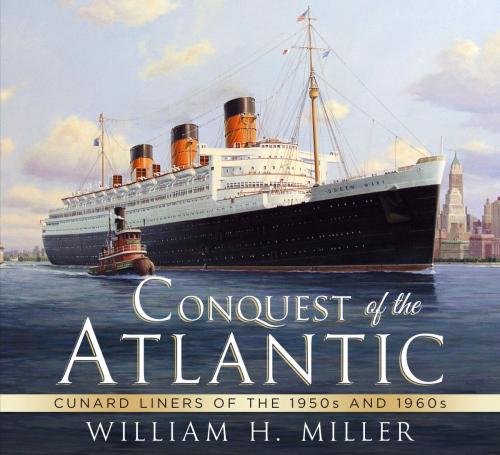Conquest of the Atlantic
Cunard Liners in the 1950s and 1960s
Nonfiction, Reference & Language, Transportation, Ships & Shipbuilding, Pictorial, History| Author: | William H. Miller | ISBN: | 1230001929201 |
| Publisher: | Fonthill Media | Publication: | September 23, 2017 |
| Imprint: | Language: | English |
| Author: | William H. Miller |
| ISBN: | 1230001929201 |
| Publisher: | Fonthill Media |
| Publication: | September 23, 2017 |
| Imprint: | |
| Language: | English |
Cunard, the most famous name in shipping, turns 175 in 2015. The company began back in 1840, with paddlewheel steamers, but grew and progressed and created some of the largest, fastest and most luxurious liners afloat in their time. The final ‘golden age’ on the Atlantic run between Europe & America was the 1950s, when the Company slogan ‘Getting There Was Half the Fun’ seemed so apt. Cunard had twelve liners running Atlantic crossings in 1958, for example, the same year the speedy passenger jet appeared and immediately stole trans-ocean travellers. The Cunard ‘cast’ of the late ’50s includes such celebrated ocean liners like the Queen Mary and Queen Elizabeth as well as others such as the Mauretania, Saxonia and smaller ships such as the Media and the Parthia. This is the story of these great ships, all still well remembered, and of life onboard them. Cunard would, of course, face furious competition with jet aircraft and, by 1969, be reduced to one Atlantic liner, the legendary Queen Elizabeth 2.
The fate of the great Cunarders was often curious, unexpected, and occasionally quite sad. The legendary Caronia was said to be most luxurious liner in the world in the 1950s. She was Cunard's fabled ‘Green Goddess,’ a ship so beloved and cherished that some passengers ‘lived’ aboard, including some for years at a time. But by the 1970s, she was past her best. She had been sold in 1968 to a Greek, Andrew Kostantinides, who planned to revive her as the discount Caribbean cruise ship Caribia. After a mere two voyages, the ship was riddled with financial troubles and left to loiter around New York harbour, moving from pier to pier. The 34,000-ton luxury cruise liner had fallen into deep neglect—she was dark, damp and permeated by stale odours. And more than once, dead rats were spotted curled in the corners of the once lavish lounges and impeccable decks.
Cunard, the most famous name in shipping, turns 175 in 2015. The company began back in 1840, with paddlewheel steamers, but grew and progressed and created some of the largest, fastest and most luxurious liners afloat in their time. The final ‘golden age’ on the Atlantic run between Europe & America was the 1950s, when the Company slogan ‘Getting There Was Half the Fun’ seemed so apt. Cunard had twelve liners running Atlantic crossings in 1958, for example, the same year the speedy passenger jet appeared and immediately stole trans-ocean travellers. The Cunard ‘cast’ of the late ’50s includes such celebrated ocean liners like the Queen Mary and Queen Elizabeth as well as others such as the Mauretania, Saxonia and smaller ships such as the Media and the Parthia. This is the story of these great ships, all still well remembered, and of life onboard them. Cunard would, of course, face furious competition with jet aircraft and, by 1969, be reduced to one Atlantic liner, the legendary Queen Elizabeth 2.
The fate of the great Cunarders was often curious, unexpected, and occasionally quite sad. The legendary Caronia was said to be most luxurious liner in the world in the 1950s. She was Cunard's fabled ‘Green Goddess,’ a ship so beloved and cherished that some passengers ‘lived’ aboard, including some for years at a time. But by the 1970s, she was past her best. She had been sold in 1968 to a Greek, Andrew Kostantinides, who planned to revive her as the discount Caribbean cruise ship Caribia. After a mere two voyages, the ship was riddled with financial troubles and left to loiter around New York harbour, moving from pier to pier. The 34,000-ton luxury cruise liner had fallen into deep neglect—she was dark, damp and permeated by stale odours. And more than once, dead rats were spotted curled in the corners of the once lavish lounges and impeccable decks.















